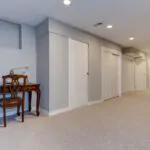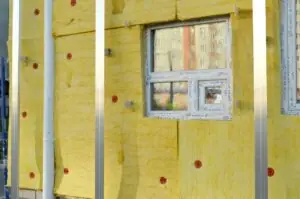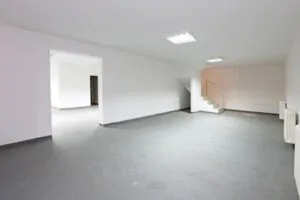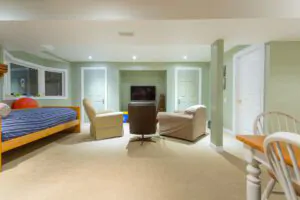Choosing the right finish for your basement ceiling transforms the look and feel of the space. A well-chosen ceiling option enhances aesthetics and also increases your home’s value by adding more usable living areas.
This guide will explore six top options for finishing your basement ceiling: suspended ceilings, drywall, PVC panels, wood planks, beadboard, and shiplap. Each brings unique benefits to the table.
Suspended ceilings make accessing ductwork and wiring easy while preserving headroom. Drywall gives a smooth appearance that can be customized with paint or textures to fit any design style.
PVC panels offer durability without needing much maintenance, imitating other materials without their downsides. Wood planks add warmth and natural beauty and come in lightweight versions for easy installation overhead.
Beadboard is both trendy and economical, easily updating an old basement’s look on a budget. Lastly, shiplap introduces texture and character with simple installation options that cover up imperfections.
From choosing Armstrong Residential’s 6″ x 48″ mineral fiber ceiling planks for customizable looks to finding clip systems that ease installation processes—the right choice depends on what you need in terms of accessibility, budget constraints, aesthetic preferences, and how much upkeep you’re willing to do.
Discover which option fits your vision best as we examine each possibility in detail.
Key Takeaways
- Suspended ceilings make it easy to access ductwork and wiring, ideal for basements where flexibility is key. They can be customized with various tiles to match your style.
- Drywall offers a smooth finish for basement ceilings and can be painted or textured to fit the room’s design. It’s a solid choice for those looking for a more traditional ceiling in their basement renovation.
- PVC panels are durable, moisture-resistant, and easy to maintain, making them great for basements prone to dampness. They also help insulate the space, keeping it warmer.
- Wood planks provide a natural look that can warm up any basement space. They’re lightweight and offer an easier installation process compared to other materials.
- Beadboard brings a cottage-style charm to any basement with its timeless appeal. It’s also easy to install and provides convenient access to above-ceiling utilities when needed.
- Shiplap is versatile enough for horizontal or vertical installation, offering unique texture and depth while covering imperfections in the ceiling effortlessly.
Why Finish Your Basement Ceiling?
Finishing your basement ceiling enhances the overall look and feel of your home. It adds value to your property and creates extra living space for you and your family.
Improved aesthetics
Upgrading your basement ceiling can massively improve how your space looks. A polished, finished ceiling turns a once ignored area into an inviting living space. Think about the difference suspended ceilings or drywall can make.
They hide ductwork and pipes, creating a clean and smooth appearance overhead. This change alone transforms your basement from feeling like an afterthought to being a central part of your home.
Choosing materials like PVC panels or wood planks adds warmth and character to any room below ground level. These options also allow for creative freedom with colors and textures that complement the rest of your house.
Imagine installing beadboard or shiplap for a cozy, cottage feel in your basement. Such touches enhance the visual appeal and make the area more welcoming for family and guests alike.
The right choice of materials can even help with insulation, keeping floors above warmer and reducing energy costs over time. Upgraded aesthetics paired with practical benefits like these prove why investing in an improved look should be part of every basement renovation project.
Increase home value
Choosing the right basement ceiling can significantly boost your home’s market appeal. A finished basement acts like a magnet for potential buyers, offering them more than just extra space; it presents a polished look that speaks volumes about a home’s upkeep and modernity.
Opting for attractive ceiling options such as coffered ceilings or tin ceilings adds character and sophistication, aspects highly sought after in the real estate market.
Investing in quality materials for your basement renovation pays off by not only enhancing its aesthetics but also by elevating your property’s overall value. For instance, incorporating durable PVC panels or elegant wood planks into your design could be the deciding factor that tips buyer interest in your favor.
Prospective buyers often gauge a property’s worth based on its finished spaces, making your choice of ceiling an essential element of home improvement with long-term benefits.
Integrating internet-enabled smart lighting systems into these new ceilings transforms ordinary basements into dynamic living areas. By doing so, you not only cater to current interior design trends but also to the growing consumer demand for smart homes.
This blend of style and technology further amplifies the attractiveness of your property to potential buyers, ensuring you enjoy the dual benefits of increased livability now and higher resale value later.
Additional living space
Turning your basement into extra living space can meet the needs of a growing family or add a private retreat. Finishing the basement adds valuable square footage, transforming it into anything from guest quarters to a cozy den.
This makes smart use of every inch in your home and could significantly enhance how you enjoy your personal space.
Meeting the 7-foot ceiling requirement ensures these new areas are comfortable and safe. With careful planning, this investment pays off by providing more room and also boosting your home’s resale value.
Consider using materials like drywall or beadboard for ceilings to make these spaces feel warm and inviting. Opting for moisture-resistant materials helps keep these new rooms dry and comfortable, turning previously underused basements into vibrant parts of your home ready for memories to be made.
Top 6 Basement Ceiling Options
When considering basement ceiling options, it’s important to explore a variety of choices to find the best fit for your space. The key is to evaluate each option based on your specific needs and preferences.
Suspended ceilings
Suspended ceilings, also known as drop or false ceilings, are highly favored for basement renovations due to their versatility and practicality. These types of ceilings consist of a grid system that holds ceiling tiles in place, providing easy access to ductwork and wiring above.
They offer a seamless way to conceal unsightly utilities while maintaining accessibility for maintenance or repairs. However, it’s essential to handle these ceiling tiles with care to prevent any damage.
For basements where headroom is precious, zero clearance suspended ceilings serve as an excellent option, allowing homeowners to maximize space without sacrificing height.
Tapping into the benefits of suspended ceilings can transform a basement into a more functional and visually appealing space. The ability to integrate new ceiling tiles offers an opportunity for creativity, allowing individuals or families seeking renovation options for their lower level living spaces the flexibility they need.
Whether it’s exploring different designs or incorporating acoustic panels for sound absorption, suspended ceilings can be tailored towards creating the ideal ambiance in each room within your basement.
Drywall
Drywall is a top choice for basement ceilings due to its smooth finish and versatility. You can textured drywall to enhance visual appeal, and it’s customizable with paint to match your overall design.
DIY enthusiasts may find drywall an attractive option for its cost-effectiveness and flexibility. It’s important to ensure proper installation and code compliance when using drywall in the basement, considering factors like waterproofing and moisture control.
When selecting a basement ceiling option, remember to evaluate how well it aligns with the purpose of the room, maintenance needs, budget constraints, as well as seeking professional advice if needed.
By keeping these considerations in mind while exploring different material options including drywall along with PVC panels or wood planks— you will be on track towards upgrading your living space effectively.
PVC panels
PVC panels are a popular choice for finishing basement ceilings. They are durable and resistant to warping, making them a long-lasting option. PVC panels also provide a hygienic and stain-free surface that is easy to maintain, ideal for waterproofing basements.
Additionally, drop ceiling installation with PVC panels can be cost-effective, making it an attractive option for those looking to upgrade their basement space without breaking the bank.
Additionally, PVC wall and ceiling panels offer temperature-controlled environments and are sought after by interior designers for creating clean and safe spaces. These features make them an excellent choice for individuals or families seeking to renovate or upgrade their basement while focusing on practicality and functionality.
Wood planks
Wood planks make for an excellent option to finish your basement ceiling. With their DIY-friendly installation, you can cover damaged drywall or popcorn ceilings without the need for demolition.
Armstrong Residential’s 6″ x 48″ mineral fiber ceiling planks in various prefinished colors, including white, offer a customizable aesthetic to suit your preferences. These lightweight wood plank ceilings not only provide a natural and warm look but are also cost-effective and attractive for finishing basement spaces.
Armstrong also provides ceiling plank clips that make the installation and maintenance of wood planks in basement ceilings easy. The versatility of wood planks allows them to be installed directly onto joists or an existing ceiling as a cover-up option, making them an ideal choice for upgrading or renovating basements.
Beadboard
Beadboard adds a touch of timeless charm to any basement space. With its customizable and easy-to-install design, it’s an attractive option for homeowners seeking a DIY project that can transform the look and feel of their basement.
The removable sections in beadboard ceilings make accessing wiring and plumbing hassle-free, offering practicality alongside its visual appeal. Additionally, this cost-effective solution is pre-finished, making it ideal for those looking to upgrade their basement without breaking the bank.
A beadboard ceiling tutorial provides valuable first-hand experience for individuals or families embarking on a home improvement journey. By incorporating tongue and groove beadboard panels into your basement design, you’ll unlock the secrets of a custom cottage-style look while adding value to your living space.
Those seeking more than just traditional drop ceilings are often inspired by the versatility that comes with using beadboard as an alternative option.
Shiplap
Shiplap is a trendy and versatile option for basement ceilings. It can effortlessly cover imperfections, while adding texture and appeal to the space. Shiplap’s horizontal or vertical installation options cater to various design preferences.
Additionally, it provides a cohesive look when used on both walls and ceilings in the basement area.
Besides its visual benefits, shiplap presents practical solutions too. For instance, it can be installed as removable panels to allow access to ductwork or utilities within the ceiling.
These features offer first-hand experience of how shiplap meets specific needs and design expectations for upgrading basements. With all these advantages, shiplap stands out as a functional and visually appealing choice for individuals seeking to enhance their basement spaces with ease.
Creative Ideas for Different Rooms
Transform your basement into a dynamic space tailored to your needs and hobbies. Let’s dive in to explore how different rooms such as home gyms, playrooms, home offices, hobby rooms, home theaters, media rooms, living spaces, “man caves,” bedrooms and guest quarters can be revamped.
Home gyms and playrooms
Transform your basement into a dynamic space with a dedicated home gym or playroom. Maximize the area by utilizing resilient, easy-to-clean flooring such as rubber tiles or vinyl planks.
Incorporate adjustable lighting and vibrant wall colors to create an invigorating ambiance for workouts, while also ensuring an engaging environment for kids to enjoy playtime. Your basement can serve as a multifunctional retreat where fitness meets fun, offering personalized zones designed specifically for each activity.
Tailor the layout of your home gym towards functional training with versatile equipment like resistance bands, kettlebells, and suspension trainers. For playrooms, consider integrating storage solutions that promote organization and safety.
Customizable shelving units and cubbies provide ample space for toys and games while maintaining a clutter-free environment. By embracing these concepts, you’ll unlock the potential of your basement to cater to various activities seamlessly.
Introduce innovative elements into your design plan based on my first-hand experience working with clients’ ever-evolving needs in creating versatile living spaces within their basements.
Combine practicality with creativity as you embark on this exciting transformation journey!
Home offices and hobby rooms
Home offices and hobby rooms in the basement offer a quiet retreat for work, creativity, or relaxation. Whether it’s pursuing professional endeavors or engaging in hobbies, a well-designed space can enhance productivity and inspiration.
Integrating robust lighting options like LED panel lights provides ample illumination for focused tasks while also creating an inviting ambiance. Incorporating durable flooring such as vinyl planks or carpet tiles ensures easy maintenance and comfort during extended periods spent in these versatile areas.
Selecting ergonomic furniture from reputable brands enhances comfort and functionality, promoting better posture and reducing strain during long hours of use. Additionally, incorporating smart storage solutions like wall-mounted shelves or modular cabinets optimizes space utilization while keeping essential supplies organized.
Implementing vibrant paint colors or custom wallpapers infuses personality into the area, crafting a stimulating environment conducive to unleashing creativity and fostering productivity.
Home theaters and media rooms
Transforming your basement into a home theater or media room can create an immersive entertainment experience for your family and friends. Integrating high-definition projectors, comfortable seating, and top-notch sound systems can elevate your space to rival commercial movie theaters.
By catering the design to accommodate low ceilings and controlled lighting, you can craft an ideal setting for movie nights and gaming sessions.
Homes with unused basement spaces are perfect candidates for creating dedicated media rooms or home theaters. With the right planning, including acoustic excellence in the design and layout of furniture, you can curate a space that not only maximizes comfort but also enhances overall viewing quality.
Embrace this opportunity to unleash creativity while selecting furnishings like reclining chairs, multimedia cabinets, blackout curtains, and ambient lighting options to suit various preferences.
Before committing to any specific design or layout, consider involving professional advice tailored towards making informed decisions about factors like budget constraints or maintenance needs.
Living spaces, “man caves,” and bedrooms
When designing living spaces, man caves, or bedrooms in your basement, it’s essential to consider the purpose of each room. Whether you’re creating a cozy entertainment area, a home office retreat, or a relaxing bedroom oasis, the ceiling choice can significantly impact the overall ambiance and functionality of the space.
For example, suspended ceilings offer versatility and easy access to wiring and plumbing for home theaters and media rooms. Wood planks can add warmth and character to man caves or bedrooms with their natural aesthetic.
PVC panels provide a durable and moisture-resistant solution ideal for multi-purpose rooms seeking practicality alongside style.
Incorporating these various basement ceiling options ensures that your living spaces become inviting havens tailored towards your specific needs while adding value to your home.
Guest quarters and multi-purpose rooms
Transforming your basement into guest quarters or a multi-purpose room can provide additional living space and boost the functionality of your home. By integrating features tailored for guests, such as a comfortable bed and storage solutions, you can create a welcoming environment for visitors.
Multi-purpose rooms offer versatility, allowing you to design spaces that fulfill various needs, from home offices to playrooms. For instance, incorporating modular furniture and adaptable storage units enables seamless transitions between different activities within the same area.
When planning these spaces, consider concepts like flexible design elements and efficient use of available square footage to maximize their potential. Additionally, integrating practical tools such as soundproofing materials and smart lighting systems can enhance the comfort and convenience of these areas while catering to diverse needs.
Incorporating durable flooring options like vinyl planks or carpet tiles ensures longevity in high-traffic zones while offering ease of maintenance for busy households.
Choosing the Right Ceiling for Your Space
Consider the function of the room, your budget, and maintenance needs. Seek professional guidance for personalized advice. Ready to explore your options?
Consider the purpose of the room
When selecting a basement ceiling option, it’s crucial to consider the intended use of the space. For example, a home office or hobby room might benefit from soundproofing materials to create a quiet and focused environment.
On the other hand, for playrooms and living spaces, easy-to-clean and durable ceiling options should be prioritized. Moreover, when designing a home theater or media room in the basement, acoustic-friendly materials can significantly enhance the viewing experience by minimizing sound reverberation.
Additionally, if you’re planning to convert your basement into guest quarters or multi-purpose rooms, choosing a ceiling that complements various decor styles will ensure flexibility while catering to diverse needs.
Keep in mind that different areas within your basement could serve multiple purposes over time. Consequently, selecting versatile ceiling materials is essential for accommodating potential future changes and ensuring long-term satisfaction with the overall design.
Finally, creating an inviting yet functional aesthetic for bedrooms and cozy living spaces requires careful consideration of both visual appeal and practicality. Opting for warm-toned wood planks or beadboard can contribute to a welcoming atmosphere while providing insulation benefits.
Evaluate budget and maintenance needs
When considering the right basement ceiling option, it’s crucial to evaluate your budget and maintenance requirements. Different materials and designs come with varying price points and upkeep demands, so understanding your financial constraints and willingness for ongoing maintenance is essential.
PVC panels and suspended ceilings offer cost-effective solutions requiring minimal upkeep, while wood planks or shiplap may require a higher initial investment but lower long-term maintenance.
Seeking professional advice can also provide insights on cost-effective options without compromising quality. Additionally, taking into account the purpose of the space will guide decisions based on functionality as well as budget considerations.
When integrating these elements into your decision-making process, you can ensure that the chosen ceiling not only enhances the aesthetics of your basement but also aligns with your financial capabilities and practical needs.
Seek professional advice
Before diving into the complexities of basement ceiling options, it’s advisable to seek professional advice. An expert can provide tailored guidance based on your space’s headroom, height restrictions, and design needs.
Consider reaching out to Armstrong Ceilings for firsthand experience in choosing the right ceiling, offering solutions that go beyond mere aesthetics. Consulting professionals unlocks secrets that enhance the practical functionality of your basement.
Remember: Seeking professional advice is more than just a recommendation; it underpins informed decision-making when exploring basement ceiling ideas to transform your space from concept to reality.
Conclusion
After exploring the top 6 basement ceiling options, consider the purpose of your space before making a decision. Evaluate your budget and maintenance needs, and seek professional advice if necessary.
Each option has its own benefits that can enhance the aesthetic appeal of various rooms in your basement. So take inspiration from these creative ideas and choose the right ceiling option for your unique space!
FAQs
1. What are the best ceiling options for my basement?
The top choices include drop ceilings, which allow easy access to your home’s network and electronic communications systems; drywall for a smooth finish; exposed beams for an industrial look; tiles with acoustic properties to reduce noise; stretch ceilings that offer a modern look; and wood panels for warmth.
2. How can I make sure my basement ceiling fits my home’s style?
Choose materials that match your home’s overall design. For example, wood panels add warmth perfect for cozy spaces, while sleek metal or stretch ceilings suit modern homes. Consider painting techniques or decorative tiles to customize further.
3. Can installing a new ceiling improve my basement’s internet connection?
Yes! By choosing the right ceiling material, like drop ceilings, you create easier access to update or enhance your home’s network cables and routers, ensuring better connectivity in your basement space.
4. Will changing my basement ceiling affect how well it blocks sound?
Absolutely! Certain materials like acoustic tiles are designed specifically to absorb sound, making them ideal if you’re looking to minimize noise between floors. This is especially useful if you use your basement as an entertainment area or workspace.






